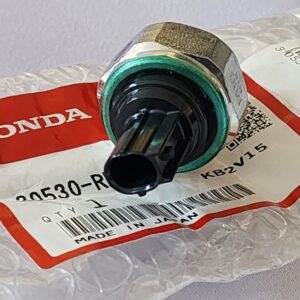Title: Oxygen Sensor: The Breath of Precision in Modern Engines
In the intricate world of automotive engineering, where air and fuel blend to power the drive, the oxygen sensor emerges as a silent yet indispensable component, ensuring optimal combustion, fuel efficiency, and emissions control. Despite its modest size, this unassuming sensor plays a pivotal role in monitoring oxygen levels in the exhaust gases, enabling the engine control unit (ECU) to adjust fuel delivery and maintain peak performance. In this blog, we’ll explore the significance of the oxygen sensor, how it works, its importance in engine operation, and its indispensable contribution to the driving experience.
### Unveiling the Oxygen Sensor
The oxygen sensor, also known as the O2 sensor, is a critical component of modern engine management systems. Positioned in the exhaust system, its primary function is to monitor the oxygen content in the exhaust gases and provide feedback to the engine control unit (ECU).
### How the Oxygen Sensor Works
The oxygen sensor operates based on the principle of a chemical reaction between oxygen ions and a ceramic element or zirconium dioxide sensor. As exhaust gases pass over the sensor, the oxygen ions in the exhaust interact with the sensor’s surface, generating a voltage signal proportional to the oxygen content. This voltage signal is then transmitted to the ECU, which uses it to adjust fuel delivery and optimize air-fuel ratio for efficient combustion.
### Importance of the Oxygen Sensor in Engine Operation
1. **Optimizing Air-Fuel Ratio**: The oxygen sensor plays a crucial role in maintaining the optimal air-fuel ratio for combustion. By continuously monitoring oxygen levels in the exhaust gases, the sensor allows the ECU to adjust fuel delivery in real-time, ensuring efficient combustion and maximizing engine performance and fuel efficiency.
2. **Reducing Emissions**: Proper air-fuel mixture is essential for minimizing emissions of harmful pollutants such as carbon monoxide (CO), nitrogen oxides (NOx), and hydrocarbons (HC). The oxygen sensor helps reduce emissions by ensuring complete combustion of fuel and optimizing catalytic converter efficiency, thereby reducing the environmental impact of vehicle operation.
3. **Enhancing Engine Performance**: Efficient combustion is essential for achieving optimal engine performance and responsiveness. The oxygen sensor ensures that the engine operates at peak efficiency by maintaining the correct air-fuel ratio, allowing for smooth acceleration, consistent power delivery, and overall driving satisfaction.
### Signs of a Failing Oxygen Sensor
– **Check Engine Light**: An illuminated check engine light on the dashboard may indicate a problem with the oxygen sensor or its circuitry.
– **Decreased Fuel Efficiency**: Reduced fuel efficiency or sudden drops in mileage may occur if the oxygen sensor is malfunctioning, resulting in incorrect fuel delivery and inefficient combustion.
– **Rough Idling or Hesitation**: Engine hesitation, rough idling, or lack of power may occur if the oxygen sensor is sending incorrect signals to the ECU, leading to improper fuel mixture and combustion.
### Conclusion
In the intricate dance of combustion and performance, the oxygen sensor stands as a silent guardian, ensuring optimal engine operation with each exhaust gas pulse. From optimizing air-fuel ratio to reducing emissions and enhancing engine performance, its role in shaping engine efficiency and reliability is indispensable. As automotive technology continues to advance, the importance of oxygen sensors in achieving optimal engine performance remains undeniably critical, ensuring that vehicles navigate the roads with efficiency, cleanliness, and precision.
Only 1 left in stock (can be backordered)
$37,904.62
Title: Oxygen Sensor: The Breath of Precision in Modern Engines
In the intricate world of automotive engineering, where air and fuel blend to power the drive, the oxygen sensor emerges as a silent yet indispensable component, ensuring optimal combustion, fuel efficiency, and emissions control. Despite its modest size, this unassuming sensor plays a pivotal role in monitoring oxygen levels in the exhaust gases, enabling the engine control unit (ECU) to adjust fuel delivery and maintain peak performance. In this blog, we’ll explore the significance of the oxygen sensor, how it works, its importance in engine operation, and its indispensable contribution to the driving experience.
### Unveiling the Oxygen Sensor
The oxygen sensor, also known as the O2 sensor, is a critical component of modern engine management systems. Positioned in the exhaust system, its primary function is to monitor the oxygen content in the exhaust gases and provide feedback to the engine control unit (ECU).
### How the Oxygen Sensor Works
The oxygen sensor operates based on the principle of a chemical reaction between oxygen ions and a ceramic element or zirconium dioxide sensor. As exhaust gases pass over the sensor, the oxygen ions in the exhaust interact with the sensor’s surface, generating a voltage signal proportional to the oxygen content. This voltage signal is then transmitted to the ECU, which uses it to adjust fuel delivery and optimize air-fuel ratio for efficient combustion.
### Importance of the Oxygen Sensor in Engine Operation
1. **Optimizing Air-Fuel Ratio**: The oxygen sensor plays a crucial role in maintaining the optimal air-fuel ratio for combustion. By continuously monitoring oxygen levels in the exhaust gases, the sensor allows the ECU to adjust fuel delivery in real-time, ensuring efficient combustion and maximizing engine performance and fuel efficiency.
2. **Reducing Emissions**: Proper air-fuel mixture is essential for minimizing emissions of harmful pollutants such as carbon monoxide (CO), nitrogen oxides (NOx), and hydrocarbons (HC). The oxygen sensor helps reduce emissions by ensuring complete combustion of fuel and optimizing catalytic converter efficiency, thereby reducing the environmental impact of vehicle operation.
3. **Enhancing Engine Performance**: Efficient combustion is essential for achieving optimal engine performance and responsiveness. The oxygen sensor ensures that the engine operates at peak efficiency by maintaining the correct air-fuel ratio, allowing for smooth acceleration, consistent power delivery, and overall driving satisfaction.
### Signs of a Failing Oxygen Sensor
– **Check Engine Light**: An illuminated check engine light on the dashboard may indicate a problem with the oxygen sensor or its circuitry.
– **Decreased Fuel Efficiency**: Reduced fuel efficiency or sudden drops in mileage may occur if the oxygen sensor is malfunctioning, resulting in incorrect fuel delivery and inefficient combustion.
– **Rough Idling or Hesitation**: Engine hesitation, rough idling, or lack of power may occur if the oxygen sensor is sending incorrect signals to the ECU, leading to improper fuel mixture and combustion.
### Conclusion
In the intricate dance of combustion and performance, the oxygen sensor stands as a silent guardian, ensuring optimal engine operation with each exhaust gas pulse. From optimizing air-fuel ratio to reducing emissions and enhancing engine performance, its role in shaping engine efficiency and reliability is indispensable. As automotive technology continues to advance, the importance of oxygen sensors in achieving optimal engine performance remains undeniably critical, ensuring that vehicles navigate the roads with efficiency, cleanliness, and precision.
| Warehouse | Inventory at warehouse 2 |
|---|



Get E-mail updates about our latest products and special offers.
Sensors and More is Jamaica’s ultimate online auto parts store. Established in 2020, we specialize in genuine electrical parts for Japanese, Read more…
Reviews
There are no reviews yet.